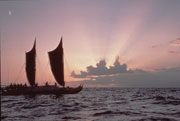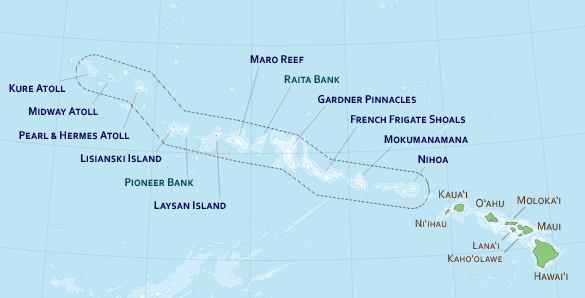Dozens of tiny islands, atolls and shoals, spanning 1,200 nautical miles of the world's largest ocean, are slowly, quietly slipping into the sea, destined to become seamounts. Hundreds of miles north of Kaua‘i, places like Nihoa, Laysan, Pearl and Hermes and Kure comprise the little known, rarely visited Northwestern Hawaiian Islands (NWHI).
Click on the island names below for a virtual visit!
If they were laid atop the continental United States, the NWHI would cover a distance equal to that between New York City and Omaha, or Boston and the Florida Everglades.
These ancient volcanic remnants with their fringes of truly wild coral reefs remind us of our past—when coral reefs and sea life across the planet thrived—a time before humans became top predator in the ocean food chain.
 The living coral reef colonies of the NWHI are a spectacular underwater landscape covering thousands of square miles. These reefs are some of the healthiest and least disturbed coral reefs remaining and comprise possibly the last large-scale, predator-dominated coral reef ecosystem on the planet. Over millennia,invertebrate animals and algae have constructed massive structures in the shallow seas. Coral animals, bonded to basalt from ancient volcanoes, secreted skeletons of calcium carbonate that formed the substance of which reefs are built. The basaltic islands eventually eroded away and subsided under their massive weight. However the upward growth of the coral reefs kept pace with the gradual sinking of the volcanic remnants, creating shallow reefs that rise to the surface of the ocean but no further. The reefs and atolls we see today represent the “footprints” of former high volcanic islands.
The living coral reef colonies of the NWHI are a spectacular underwater landscape covering thousands of square miles. These reefs are some of the healthiest and least disturbed coral reefs remaining and comprise possibly the last large-scale, predator-dominated coral reef ecosystem on the planet. Over millennia,invertebrate animals and algae have constructed massive structures in the shallow seas. Coral animals, bonded to basalt from ancient volcanoes, secreted skeletons of calcium carbonate that formed the substance of which reefs are built. The basaltic islands eventually eroded away and subsided under their massive weight. However the upward growth of the coral reefs kept pace with the gradual sinking of the volcanic remnants, creating shallow reefs that rise to the surface of the ocean but no further. The reefs and atolls we see today represent the “footprints” of former high volcanic islands.
The NWHI coral reefs are the foundation of an ecosystem that hosts more than 7,000 species, including marine mammals, fishes, sea turtles, birds, and invertebrates. Many are rare, threatened, or endangered. At least one quarter are endemic, found nowhere else on Earth. Many more remain unidentified or even unknown to science. Unexplored deep-sea habitats, expensive and challenging to survey, may provide new species records to science for decades. Even the shallow coral reef habitats hold new species to science. This is especially true for invertebrates and algae.
Besides supporting these species, the coral reefs and bits of land of the NWHI provide an amazing geological record of the volcanic powers that created the area and the erosion and subsidence that sculpted it.
 Beyond biological significance, the area boasts a rich cultural history. During their Trans-Pacific voyages, ancient Polynesians sailed these waters and used these islands for centuries as places of residence and worship. When Western explorers found these islands they raced to claim them for their own nations after original Polynesian settlement. Entrepreneurs tried to make a living from natural resources found there, and the world’s first global communications network linked through these islands. During World War II the US military developed Midway into a naval air station and submarine base, and the definitive battle of the conflict (Battle of Midway 1942) occurred in adjacent waters.
Beyond biological significance, the area boasts a rich cultural history. During their Trans-Pacific voyages, ancient Polynesians sailed these waters and used these islands for centuries as places of residence and worship. When Western explorers found these islands they raced to claim them for their own nations after original Polynesian settlement. Entrepreneurs tried to make a living from natural resources found there, and the world’s first global communications network linked through these islands. During World War II the US military developed Midway into a naval air station and submarine base, and the definitive battle of the conflict (Battle of Midway 1942) occurred in adjacent waters.

